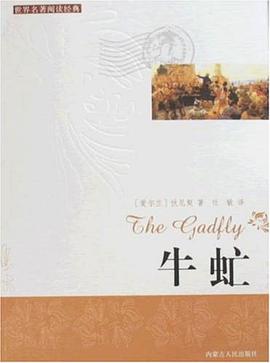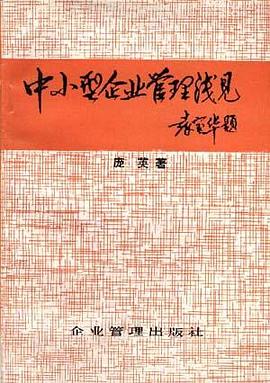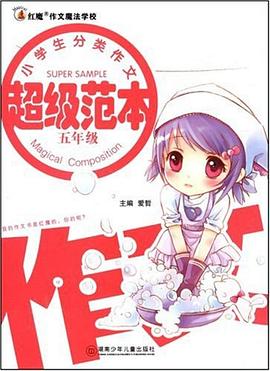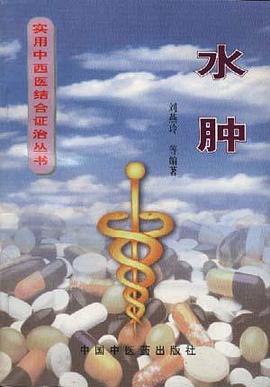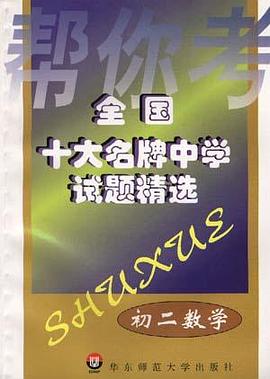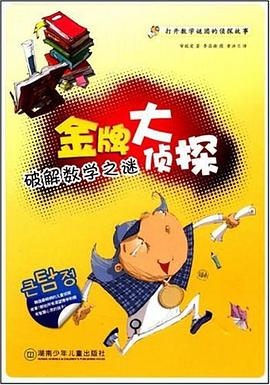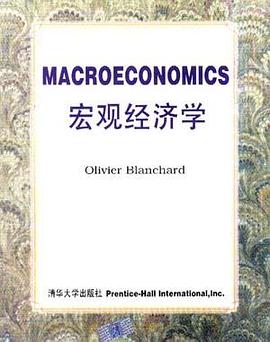

具体描述
内容提要
作者写作本书的目的在于和读者分享他本人过去20年在宏观经济
学研究工作中的收获,并帮助读者建立起关于宏观经济学的观念和意
识。和其他宏观经济学教科书相比,本书包含了一些其他教科书未论
及的问题,如预期理论、现代经济学的开放性等。而且本书经常在多
个层面上进行理论和实际的比较,引用了较多熔深度和趣味性于一炉
的实例。
作者以一个重要模型贯穿全书,其核心是商品市场、金融市场和
劳动市场的均衡条件。本书首先介绍IS-LM短期经济模型,讨论商品
市场和金融市场的均衡,并把对经济的预期在宏观经济决策方面的作
用和增强现代经济开放性的重要性作为其中的两个主题。接着在中长
期理论中,介绍劳动市场均衡、总供给与总需求模型,分析高失业率
和高通货膨胀率时期的特点,以及经济增长中资本积累和技术进步的
作用。最后,读者可用前面章节中学到的方法去分析当今世界最重要
的几个经济问题,回顾宏观经济学在过去50年中的演进过程,宏观
经济政策的作用及其所受到的限制,以及当前的研究方向。
本书既可作为经济管理专业本科生和研究生的教学用书,也可供
其他经济工作者参考。
作者简介
目录信息
PART ONE - INTRODUCTION 1
CHAPTER 1 - A TOUR OF THE WORLD
1 -1 WHAT IS MACROECONOMICS?
The Simplifications of Macroeconomics
1 Why Macroeconomists Sometimes
Disagree
1-2 LOOKING AT THE WORLD
The United States ?The European
Union ?Japan 11
1-3 LOOKINGAHEAD
CHAPTER 2 - A TOUR OF THE BOOK
2-1 AGGREGATE OUTPUT
GDP, Value Added, and Income ? Nominal and Real GDP
2-2 THE OTHER MAJOR MACROECONOMIC
VARIABLES
The Unemployment Rate ?The
Inflation Rate ?Budget Deficits and
Trade Deficits
2-3 A ROAD MAP
PART TWO - THE BASICS
CHAPTER 3 - TME GOODS MARKET
3-1 THE COMPOSITION OF GDP
3-2 THE DETERMINATION OF DEMAND
Consumption (C) ?Investment (I)
?Government Spending (G)
3-3 THE DETERMINATION OF
EQUILIBRIUM OUTPUT
The Algebra ?A Graph ?In
Words
3-4 INVESTMENT EQUALS SAVING: AN
ALTERNATIVE WAY OF THINKING ABOUT
GOODS-MARKET EQUILIBRIUM
3-5 THE PARADOX OF SAVING
3-6 IS THE GOVERNMENT REALLY
OMNIPOTENT? A WARNING
CHAPTER 4 - THE GOODS MARKET:
DYNAMICS
4-1 PRODUCTION, SALES, AND
INVENTORY INVESTMENT
Dividing Time ?Production and Sales
?Equilibrium in the Goods Market
Revisited ?The Dynamic Effects of
an Increase in Government Spending
?Using a Graph
4-2 GOING EMPIRICAL
Estimating the Marginal Propensity to
Consume ?Allowing for Lags ? Correlation Versus Causality
4-3 SlMULATING THE ESTIMATED
MODEL
A-A CONCLUSIONS
CHAPTER 5 - FlNANCIAL MARKETS
5-1 MONEY VERSUS BONDS
The Basic Choice ?The Demand for
Money ?The Demand for Bonds
?Money Demand and the Interest Rate:
The Evidence
5-2 THE DETERMINATION OF THE
INTEREST RATE: 1
Money Demand, Money Supply, and the
Equilibrium Interest Rate ?Monetary
Policy and Open Market Operations ? Monetary Policy and the Interest Rate
5-3 THE DETERMINATION OF THE
INTEREST RATE: 11
The Role of Banks ?The Determination
of the Money Supply ?The Effects of
an Open Market Operation ? Conclusions: Money Demand and Money
Supply
CHAPTER 6 - GOODS AND FlNANCIAL
MARKETS: THE IS-LM
6-1 THE GOODS MARKET AND THE IS
RELATION
Investment, Sales, and the Interest Rate
?The IS Curve ?Shifts in the IS
Curve
6-2 FlNANCIAL MARKETS AND THE LM
RELATION
Real Money, Real Income, and the Interest
Rate ?The LM Curve ?Shifts in
the LM Curve
6-3 THE IS-LM MODEL: EXERCISES
Fiscal Policy, Activity, and the Interest Rate
?Mohetary Policy, Activity, and the
Interest Rate ?Using a Policy Mix
6-4 ADDING DYNAMICS
6-5 DOES THE IS-LM MODEL ACTUALLY
CAPTURE WHAT HAPPENS IN THE
ECONOMY?
PART THREE - EXPECTATIONS
CHAPTER 7 - EXPECTATIONS: THE BASIC
TOOLS
7-1 NOMINAL VERSUS REAL INTEREST
RATES
Computing the Real Interest Rate ? Nominal and Rfeal Interest Rates in the
United States Since 1978
7-2 EXPECTED PRESENT DlSCOUNTED
VALUES
Computing Expected Present Discounted
Values ?Applications ?Nominal
Versus Real Interest Rates, and Present
Values
7-3 NOMINAL AND REAL INTEREST
RATES, AND THE IS-LM MODEL
APPENDIX: DERIVING THE PRESENT
DlSCOUNTED VALUE USING REAL OR
NOMINAL INTEREST RATES
CHAPTER 8 - EXPECTATIONS,
CONSUMPTION, AND INVESTMENT
8-1 CONSUMPTION
The Very Foresighted Consumer ?An
Example ?Toward a More Realistic
Description ?Putting Things
Together: Current Income, Expectations,
and Consumption
8-2 INVESTMENT
Investment and Expectations ofProfit
?A Convenient Special Case ? Current Versus Expected Profit ? Profit and Sales
8-3 THE VOLATILITY OF CONSUMPTION
AND INVESTMENT
APPENDIX: DERIVATION OF THE EXPECTED
PRESENT VALUE OF PROFITS WHEN
FUTURE PROFITS AND INTEREST
RATES ARE EXPECTED TO BE THE
SAME AS TODAY
CHAPTER 9 - FlNANCIAL MARKETS AND
EXPECTATIONS
9-1 BONDPRICESANDTHEYIELDCURVE
Bond Prices as Present Values ? Arbitrage and Bond Prices ?From
Bond Prices to Bond Yields ?The
Yield Curve and Economic Activity
9-2 THE STOCK MARKET AND
MOVEMENTS IN STOCK PRICES
Stock Prices as Present Values ?The
Stock Market and Economic Activity
9-3 BUBBLES, FADS, AND STOCK PRICES
APPENDIX: ARBITRAGEAND STOCK PRICES
185
CHAPTER 10- EXPECTATIONS, POLICY,
AND OUTPUT
10-1 EXPECTATIONS AND DECISIONS:
TAKING STOCK
Expectations and the IS Relation ? The LM Relation Revisited
10-2 A FlRST EXERCISE: MONETARY
POLICY, EXPECTATIONS, AND OUTPUT
10-3 DEFICIT REDUCTION, EXPECTATIONS,
AND ECONOMIC ACTIVITY
10-4 THE CLINTON DEFICIT REDUCTION
PACKAGE
The Design of a Program ?The
Outcome
10-5 ON TO THE OPEN ECONOMY
PART FOUR - OPENNESS
CHAPTER 1 1 - OPENNESS IN GOODS AND
FlNANCIAL MARKETS
11-1 OPENNESS IN GOODS MARKETS
Nominal Exchange Rates ?Real
Exchange Rates
11-2 OPENNESS IN FlNANCIAL MARKETS
The Balance of Payments ?The
Choice Between Domestic and Foreign
Assets
11-3 CONCLUSIONS AND A LOOK AHEAD
CHAPTER 12 - THE GOODS MARKET IN AN
OPEN ECONOMY
12-1 THE IS RELATION IN THE OPEN
ECONOMY
The Demand for Domestic Goods ? The Determinants of the Demand for
Domestic Goods
12-2 EQUILIBRIUM OUTPUT AND THE
TRADE BALANCE
12-3 INCREASES IN DEMAND, DOMESTIC
OR FOREIGN
Increases in Government Spending ? Increases in Foreign Demand ? Games That Countries Play
12-4 DEPRECIATION, THE TRADE BALANCE,
AND OUTPUT
Depreciation and the Trade Balance: The
Marshall-Lerner Condition ?The
Effects of a Depreciation ? Combining Exchange-Rate and Fiscal
Policies
12-5 LOOKING AT DYNAMICS: THE
J-CURVE
12-6 SAVING,INVESTMENT, AND TRADE
DEFICITS
APPENDIX: DERIVATION OF THE MARSHALL-
LERNER CONDITION
CHAPTER 13 - OUTPLJT, THE INTEREST
RATE, AND THE EXCHANGE RATE
13-1 EQUILIBRIUM IN THE GOODS MARKET
13-2 EQUILIBRIUM IN FlNANCIAL
MARKETS
Money Versus Bonds ?Domestic
Bonds Versus Foreign Bonds
13-3 PUTTING GOODS AND FlNANCIAL
MARKETS TOGETHER
13-4 THE EFFECTS OF POLICY IN AN OPEN
ECONOMY
The Effects of Fiscal Policy in an Open
Economy ?The Effects of Monetary
Policy in an Open Economy
13-5 FlXED EXCHANGE RATES
Pegs, Crawling Pegs, Bands, and the EMS
?Pegging the Exchange Rate, and
Monetary Control ?Fiscal Policy
Under Fixed Exchange Rates
APPENDIX: FlXED EXCHANGE RATES,
INTEREST RATES, AND CAPITAL
MOBILITY
CHAPTER 14 - EXPECTATIONS,
EXCHANGE-RATE MOVEMENTS, AND
EXCHANGE-RATE CRISES
14-1 THE DETERMINANTS OF THE REAL
EXCHANGE RATE
Real Interest Rates and the Real Exchange
Rate ?Long-Term Real Interest Rates
and the Real Exchange Rate ?The
Real Exchange Rate, Trade, and Interest
Rate Differentials
14-2 THE DANCE OF THE DOLLAR IN THE
1980s
14-3 THE APPRECIATION OF THE YEN IN
THE 1990s
14-4 EXCHANGE RATES, MONETARY
POLICY, AND NEWS
Monetary Policy, Interest Rates, and
Exchange Rates Policy and
Expectations
14-5 FlXED EXCHANGE RATES AND
EXCHANGE-RATE CRISES
Crises in the European Monetary System
APPENDIX: FROM NOMINAL TO REAL
INTEREST PARITY
PART FIVE - THE SUPPLY SIDE
CHAPTER 15 - THE LABOR MARKET
15-1 A TOUR OF THE LABOR MARKET
The Large Flows of Workers ? Differences Across Workers ? Movements in Unemployment
15-2 WAGE DETERMINATION
Bargaining ?Efficiency Wages ? Wages and Unemployment
15-3 PRICE DETERMINATION
15-4 THE NATURAL RATE OF
UNEMPLOYMENT
The Wage-Setting Relation ?The
Price-Setting Relation ?Equilibrium
Real Wages, Employment, and
Unemployment ?From
Unemployment to Output
15-5 WHERE WE GO FROM HERE
APPENDTX: WAGE- AND PRICE-SETTING
RELATIONS VERSUS LABOR SUPPLY
AND LABOR DEMAND
CHAPTER 16 - PLITTING ALL MARKETS
TOGETHER
16-1
AGGREGATE SUPPLY
The Derivation of the Aggregate Supply
Relation ?The Aggregate Supply
Relation and the Natural Level of Output
16-2
16-3
16-4
AGGREGATE DEMAND
MOVEMENTS IN OUTPUT AND PRICES
THE EFFECTS OF A MONETARY
EXPANSION
The Dynamics of Adjustment ? Looking Behind the Scene ?The
Neutrality of Money
16-5 A DECREASE IN THE BUIDGET DEFICIT
The Budget Deficit, Output, and the
Interest Rate ?Budget Deficits,
Output, and Investment
16-6 MOVEMENTS IN THE PRICE OF OlL
Effects on the Natural Rate of
Unemployment ?The Dynarnics of
Adjustment
16-7 CONCLUSIONS
The Short Run Versus the Long Run
?Shocks and Propagation Mechanisms
?Output, Unemployment, and
Inflation
CHAPTER 17 - THE PHILLIPS CURVE
17-1 INFLATION, EXPECTED INFLATION,
AND UNEMPLOYMENT
17-2 THE PHILLIPS CURVE
The Early Incarnation ?Mutations
?Back to the Natural Rate of
Unemployment
17-3 A SUMMARY AND MANY WARNINGS
The Inflation Process and the Phillips Curve
?Differences in the Natural Rate
Across Countries ?Variations in Ihe
Natural Rate over Time ?The Limits
of Our Understanding
APPENOIX: FROM THE. AGGREGATE SUPPLY
RELATION TO THE PHILLIPS CURVE
CHAPTER 18- INFLATION, DlSINFLATION,
AND UNEMPLOYMENT
18-1 INFLATION, OUTPUT, AND
UNEMPLOYMENT
The Phillips Curve: Unemployment and the
Change in Inflation ?Okun's Law:
Output Growth and Changes in
Unemployment ?The Aggregate
Demand Relation: Output Growth, Money
Growth, and Inflation
18-2 THELONGRUN
18-3 DlSINFLATION: THE ISSUES
A First Pass ?Expectations and
Credibility: The Lucas Critique ? Nominal Rigidities and Contracts
18-4 THE U.S. DISINFLATION, 1979-1985
CHAPTER 19 - INFLATION, INTEREST
RATES, AND EXCHANGE RATES
19-1 MONEY GROWTH, INFLATION, AND
INTEREST RATES
Real and Nominal Interest Rates ? The Short Run ?The Long Run
?Dynamics ?Evidence on the Fisher
Hypothesis
19-2 FlXED EXCHANGE RATES AND
DEVALLJATIONS
Aggregate Demand Under Fixed Exchange
Rates ?Aggregate Demand and
Aggregate Supply ?What
Devaluations Can Do ?Whether and
When to Devalue
PART SIX - PATHOLOGIES
CHAPTER 20 - PATHOLOGIES 1: HlGH
U N EM PLOYMENT
20-1 THEGREAT DEPRESSION
The Fall in Spending ?The
Contraction in Nominal Money ?The
Adverse Eftects of Deflation ?Thc
Recovery
20-2 UNEMPLOYMENT IN EUROPE
Labor Market Rigidities ?Hysteresis
20-3 CONCLUSIONS
CHAPTER 21 - PATHOLOGIES 11: HlGH
INFLATION
21-1 BUDGET DEFICITS AND MONEY
CREATION
21-2 INFLATION AND REAL MONEY
BALANCES
21-3 DEFICITS, SEIGNORAGE, AND
INFLATION
The Case of Constant Money Growth ? Dynamics and Increasing Inflation ? Hyperinflations and Economic Activity
21-4 HOW Do HYPERINFLATIONS END?
The Elements of a Stabilization Program
?Can Stabilization Programs Fail?
?The Costs of Stabilization
21-5 CONCLUSIONS
PART SEVEN - THE LONG RUN
CHAPTER 22 - THK FACTS OF GROWTH
22-1 GROWTH IN RlCH COUNTRIES SlNCE
1950 ?
22-2 A BROADER LOOK ACROSS TlME AND
SPACE
Looking Across Two Millennia ? Looking Across Countries
22-3 THINKING ABOUT GROWTH: A
PRIMER
The Aggregate Production Function ? The Sources of Growth
CHAPTER 23 - SAVING, CAPITAL
ACCUMULATION, AND OUTPUT
23-1 INTERACTIONS BETWEEN OUTPUT
AND CAPITAL
The Effects of Capital on Output ? The Effects of Output on Capital
Accumulation
23-2 IMPLICATIONS OF ALTERNATIVE
SAVING RATES
Dynamics of Capital and Output ? Steady-State Capital and Output ? The Saving Rate and Output ?The
Saving Rate and the Golden Rule
23-3 GETTING A SENSE OF MAGNITUDES
23-4 PHYSICAL VERSUS HUMAN CAPITAL
Extending the Production Function ? Human Capital, Physical Capital, and
Output ?Endogenous Growth
CHAPTER 24 - TECHNOLOGICAL
PROGRESS AND GROWTH
24-1 THE DETERMINANTS OF
TECHNOLOGICAL PROGRESS
R&D Spending Decisions ?R&D,
Ideas, and Patent Laws ?R&D
Spending and Technological Progress
2-4-2 TECHNOLOGICAL PROGRESS AND THE
PRODUCTION FUNCTION
24-3 TECHNOLOGICAL PROGRESS AND THE
RATE OF GROWTH
Interactions Between Output and Capital
?Dynamics of Capital and Output
?The Effects of the Saving Rate
24-4 THE FACTS OF GROWTH REVISITED
Capital Accumulation Versus Technological
Progress ?Why Has Technological
Progress Slowed Since the Mid-1970s?
24-5 EPILOGUE: THE SECRETS OF GROWTH
APPENDIX: CONSTRUCTING A MEASURE OF
TECHNOLOGICAL PROGRESS
PART EIGHT - CHANGE AND
TRANSITION 509
CHAPTER 25 - TECHNOLOGICAL
PROGRESS, UNEMPLOYMENT, AND
WAGES
25-1 PRODUCTIVITY, OUTPUT, AND
UNEMPLOYMENT IN THE SHORT RUN
511
Technological Progress, Aggregate Supply,
and Aggregate Demand ?The
Empirical Evidence
25-2 PRODUCTIVITY AND THE NATURAL
RATE OF UNEMPLOYMENT
Price and Wage Setting Revisited ? The Natural Rate of Unemployment ? The Empirical Evidence
25-3 TECHNOLOGICAL PROGRESS AND
DlSTRIBUTION EFFECTS
The Increase in Wage Inequality ?The
Causes of Increased Wage Inequality
CHAPTER 26 - TRANSITION IN EASTERN
KUROPE
26-1 AN OVERVIEW
26-2 ECONOMIC GROWTH UNDER
CENTRAL PLANNING
26-3 EXPLAINING THE DECLINE IN
OUTPUT
Measurement, Stabilization, and Structural
Change ?Shifts in Relative Demand
and Aggregate Employment ? Transition and the Decrease in
Employment
26-4 SCENARIOS FOR THE FUTURE
A Scenario of Sustained Transition and
Growth ?The Dangers Ahead
PART NINE - POLICY
CHAPTER 27 - SHOULD POLICY MAKERS
BE RESTRAINED?
27-1 UNCERTAINTY AND POLICY
How Much Do Macroeconomists Actually
Know? ?Should LJncertainty Lead
Policy Makers to Do Less? ? Uncertainty and Restraints on Policy
Makers
27-2 EXPECTATIONS AND POLICY
Hijackings and Negotiations ? Inflation and Unemployment Revisited
554 ?Establishing Credibility ?Time
Consistency and Restraints on Policy
Makers
27-3 POLITICS AND POLICY
Games Between Policy Makers and Voters
559 ?Games Between Policy Makers
?Back to the Balanced-Budget
Amendment
CHAPTER 28 - MONETARY POLICY: A
SUMMING UP
28-1
TTHE OPTIMAL INFLATION RATE
The Costs of Inflation ?The Benefits
of Inflation ?The Optimal Inflation
Rate: The Current Debate
28-2
MONEY VERSUS LlQUIDlTY
Money and Other Liquid Assets. ?The
Demand for Money Revisited ? Implications for Monetary Policy
THE FED IN ACTION
The Fed's Mandate ?The
Organization of the Fed ?The
Instruments of Monetarv Policy ?The
Current Versus Future Taxes ?Debt
and Primary Surpluscs ?The
Evolution of the Debt-to-GDP Ratio
29-2 FOUR ISSUES IN FlSCAL POLICY
Ricardian Equivalence ?Defidts.
Output Stabilization, and the Cyclically
Adjusted Deficit ?Wars and Deficits
?The Dangers of Very High Deht
29-3 THEU.S. BUDGETDEFICIT
PART TEN - EPILOGUE
CHAPTER 30 - THE STORY OF
MACROECONOM 1 CS
30-1 KEYNES AND THE GREAT
DEPRESSION
30-2 THE NEOCLASSICAL SYNTHESIS
Progress on All Fronts ?Keynesians
Versus Monetarists
30-3 THE RATIONAL-EXPECTATIONS
CRITIQUE
The Three Implications of Rational
Expectations ?The Integration of
Rational Expectations
30-4 CURRENT DEVELOPMENTS
· · · · · · (收起)
读后感
介于初级与中级之间 讲的范围很广,不是很深 讲的范围很广,但又没有什么乐趣,正规的教科书 所以这方面比不上mankiw 不是很深 数学方面高中数学可以对付 拓展很少 比不上dornbusch 不过因为是英文版 打个4分 毕竟mankiw和dornbusch的大多用的翻译过来的
评分原版当然是不错了,但翻译得,呵呵。看看这个链接吧 http://bbs.pinggu.org/thread-1277742-1-1.html 第五版的也没好到哪去。第六版,还没看,但发现作者有了变化。不知道为什么这两版出版的时间间隔这么短。
评分小结于博客: http://www.dimensionmind.com/?p=243 宏观这门课,教材用的是奥利维尔·布兰查德写的《宏观经济学》,这边教材和“曼昆”的“萨缪尔森”的宏观经济学号称宏观的三大教材巨头,几乎所有的高校都用这三本教材,选择布兰查德的版本作为MBA教材,是考虑其更适合管理...
评分原版当然是不错了,但翻译得,呵呵。看看这个链接吧 http://bbs.pinggu.org/thread-1277742-1-1.html 第五版的也没好到哪去。第六版,还没看,但发现作者有了变化。不知道为什么这两版出版的时间间隔这么短。
评分小结于博客: http://www.dimensionmind.com/?p=243 宏观这门课,教材用的是奥利维尔·布兰查德写的《宏观经济学》,这边教材和“曼昆”的“萨缪尔森”的宏观经济学号称宏观的三大教材巨头,几乎所有的高校都用这三本教材,选择布兰查德的版本作为MBA教材,是考虑其更适合管理...
用户评价
强过曼昆那本
评分强过曼昆那本
评分强过曼昆那本
评分强过曼昆那本
评分强过曼昆那本
相关图书
本站所有内容均为互联网搜索引擎提供的公开搜索信息,本站不存储任何数据与内容,任何内容与数据均与本站无关,如有需要请联系相关搜索引擎包括但不限于百度,google,bing,sogou 等
© 2025 book.quotespace.org All Rights Reserved. 小美书屋 版权所有

